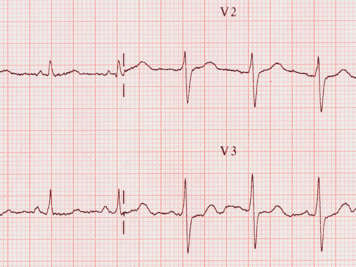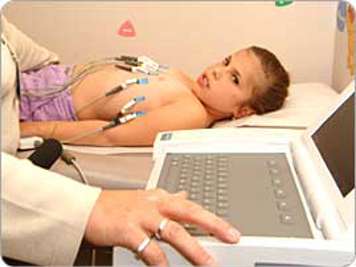An electrocardiogram (ECG) records the electrical activity of your child's heart.
If the doctor needs more information, your child may need to use a Holter monitor or a telephone transmitter at home for a day or more.
Electrocardiogram

What is an electrocardiogram?
An electrocardiogram is a test that records the electrical activity of your child’s heart on a graph.
The test gives the doctor information about:
- your child’s heart rate
- any irregularity in the heart rhythm
- the size of the heart muscle

How is an ECG done?
The test takes about 10 minutes. It does not hurt.
A technologist will give your child the test. Technologists are people who are trained to give tests on the machines in the hospital.
The technologist will put 13 small stickers called electrodes on your child’s arms, legs, and chest. Each sticker has a wire attached to it.
Your child will lie down on a bed. Your child will need to lie completely still for about 1 minute while the recording is taken.
The technologist will remove the stickers when the test is finished.
Getting the results
A cardiologist will read the ECG recording. This doctor will send a report to the doctor who ordered the test. Your child’s doctor will discuss the results with you.
Holter monitor
What is a Holter monitor?
A Holter monitor is a small machine that continuously records your child's heartbeat. It differs from an electrocardiogram (ECG) in that the monitor records this information continuously for24 or 48 hours.
How is the monitoring done?
The heartbeat is monitored by a small tape recorder attached to stickers called electrodes that are attached to your child's chest. The areas where the electrodes are to be placed are marked and the skin is rubbed with a special tape. This helps to make sure the recording is clear. The stickers are applied, held on with tape, and kept in place by a vest that your child wears. She carries the tape recorder on a strap that goes over the shoulder.

What do I do when my child is wearing a Holter monitor?
The nurse will show you how to work the monitor and find the event button. Your child may continue all normal activities, except bathing, showering, or swimming. You will be given a diary in which you will list your child's daily activities. Make a note in the diary if your child complains of chest pain, dizziness, or fast heart rate. If any of these symptoms occur, push the event button on the monitor and write the symptom in the diary.
Getting the results of the Holter test
Your child’s cardiologist will give you the results of your child’s Holter test. He can also answer your questions about the test.
Telephone transmitter
What is a telephone transmitter?
Children with some types of heart rhythm problems may be given a telephone transmitter that they take home with them to monitor how their hearts are doing. This little box is simply placed on the chest and rigged up so that the heart rate can be checked over the phone. Sending an ECG this way is known as telephonic monitoring.
The technician at the hospital who takes the call can print out a copy of the test, which the doctor can then review. The transmitter helps monitor the heart's rhythm. It is convenient, enabling the patient to send the information from home rather than having to come into the hospital.